pt 3 Before Birth and Prenatal Development
1/163
There's no tags or description
Looks like no tags are added yet.
Name | Mastery | Learn | Test | Matching | Spaced |
|---|
No study sessions yet.
164 Terms
CONCEIVING A NEW LIFE
1. HOW FERTILIZATION TAKES PLACE
2. WHAT CAUSES MULTIPLE BIRTHS?
1. HOW FERTILIZATION TAKES PLACE
Fertilization/Conception
Ovulation
Fertilization / Conception
is the process by which sperm and ovum—the male and female gametes, or sex cells—combine to create a single cell called a zygote.
Ovulation
• Rupture of a mature follicle in either ovary and expulsion of its ovum—occurs about once every 28 days until menopause.
o Ovum: Swept along through one of the fallopian tubes by the cilia, tiny hair cells, toward the uterus, or womb.
o Sperm: Deposited in the vagina, they try to swim through the cervix, the opening of the uterus, and into the fallopian tubes.
2. WHAT CAUSES MULTIPLE BIRTHS?
Dizygotic Twins/Fraternal Twins
Monozygotic Twins/Identical Twins
MECHANISMS OF HEREDITY
1. THE GENETIC CODE
2. WHAT DETERMINES SEX?
3. PATTERNS OF GENETIC TRANSMISSION
4. GENETIC AND CHROMOSOMAL ABNORMALITIES
5. GENETIC COUNSELING AND TESTING
Genetic Code
Sequence of bases within the DNA molecule; governs the formation of proteins that determine the structure and functions of living cells.

Heredity
- the inborn factors, inherited from one's biological parents that affect development.
Heredity
The basis of heredity is called deoxyribonucleic acid (DNA). With the genetic code being
adenine (A),
thymine(T),
cytosine (C),
guanine (G).
Chromosomes
Coils of DNA that consist of smaller segments called genes.
Deoxyribonucleic Acid (DNA)
A double-helix structure which resembles a long, spiraling ladder whose steps are made of pairs of chemical units called bases.
Genes
Small segments of DNA located in definite positions on particular chromosomes; functional units of heredity.
Bases
The "letters" of the genetic code.
• adenine (A), thymine (T), cytosine (C), and guanine (G).
Human Genome
The complete sequence of genes in the human body.
• Every cell in the normal human body.
o 23 pairs of chromosomes—46 in all.
Mitosis
A process by which the non–sex cells divide in half over and
over again, the DNA replicates itself, so that each newly
formed cell has the same DNA structure as all the others.
• Mutation: Permanent alterations in genetic material.
Meiosis
The sex cells undergo when they are developing, each sex
cell ends up with only 23 chromosomes— one from each
pair.
• When sperm and ovum fuse at conception, they produce a zygote with 46 chromosomes, 23 from the father and 23 from the mother.
2. WHAT DETERMINES SEX?
At conception: the 23 chromosomes from the sperm and the 23 from the ovum form 23 pairs.
Autosomes
In humans, the 22 pairs of chromosomes not related to sexual expression.
Sex Chromosomes
Pair of chromosomes that determines sex. The twenty-third pair—one from the father and one from the mother
o Sex chromosome of every ovum is an X chromosome.
It is the father's sperm that determines the sex of the child
with the ovum being a default X chromosome, it is up to the sperm to govern the baby's sex.
3. PATTERNS OF GENETIC TRANSMISSION
1. Dominant and Recessive Inheritance
2. Genotypes and Phenotypes: Multifactorial Transmission
3. Epigenesis: Environmental Influence on Gene Expression
Alleles
Two or more alternative forms of a gene that occupy the same position on paired chromosomes and affect the same trait.
1. Dominant and Recessive Inheritance
Alleles
Homozygous
Heterozygous
Types of Inheritance
Dominant Inheritance
Recessive Inheritance
Polygenic Inheritance
Every person receives a pair of alleles for a given characteristic from each parent.
homozygous - Possessing two identical alleles for a trait.
heterozygous - Possessing differing alleles for a trait.
Types of Inheritance
- dominant inheritance,
- Recessive inheritance
- polygenic inheritance,
- Sex-linked inheritance
- dominant inheritance
when a person is heterozygous for a particular trait, the dominant allele governs.
Pattern of inheritance in which, when a child receives different alleles, only the dominant one is expressed.
Recessive inheritance
occurs only when a person receives two recessive alleles, one from each parent.
Pattern of inheritance in which a child receives identical recessive alleles, resulting in expression of a nondominant trait.
polygenic inheritance,
the interaction of several genes. And traits may also be affected by mutations: or permanent alterations found in the genetic material.
Pattern of inheritance in which multiple genes at different sites on chromosomes affect a complex trait.
2. Genotypes and Phenotypes: Multifactorial Transmission
multifactorial transmissions
phenotype
genotype
multifactorial transmissions
the trait could have a strong genetic base but will also be affected by the environment (ie being musically gifted is an inherited trait, but it's development will depend on the environment—if its being supported and praised by parents or shunned and discouraged)
phenotype
Observable characteristics
genotype
underlying genetic makeup
3 Epigenesis: Environmental Influence on Gene Expression
epigenesis
o Imprinting:
epigenesis
or the epigenetic framework which refers to the molecules attached to a gene's DNA. One example will be genome or genetic imprinting where genetic information inherited from one parent is activated but the other parent is not, it plays an important role in fetal growth and development.
Genomic Imprinting
The differential expression of certain genetic traits, depending on whether the trait has been inherited from the mother or the father.
▪ In inherited gene pairs, genetic information inherited from one parent is activated, but genetic information from the other parent is suppressed.
▪ Eg. Prader-Willi Syndrome / Angelman Syndrome
4. GENETIC AND CHROMOSOMAL ABNORMALITIES
1. Dominant or Recessive Inheritance of Defects
2. Sex-Linked Inheritance of Defects
3. Chromosomal Abnormalities
1. Dominant or Recessive Inheritance of Defects
Incomplete Dominance
• Pattern of inheritance in which a child receives two different alleles, resulting in partial expression of a trait.
2. Sex-Linked Inheritance of Defects
Pattern of inheritance in which certain characteristics carried on the X chromosome inherited from the mother are transmitted differently to her male and female offspring.
o Males receive only one copy of any gene that happens to be carried on the sex chromosomes, whereas females receive two copies.
2. Sex-Linked Inheritance of Defects
o Carriers
▪ Heterozygote females who carry one “bad” copy of a recessive gene and one “good” one.
o Sex-Linked Recessive Disorders
▪ More common in males than in females.
▪ Eg. red-green color blindness, hemophilia, and Duchenne muscular dystrophy.
Gene-Linked Abnormalities

Gene-Linked Abnormalities

Gene-Linked Abnormalities
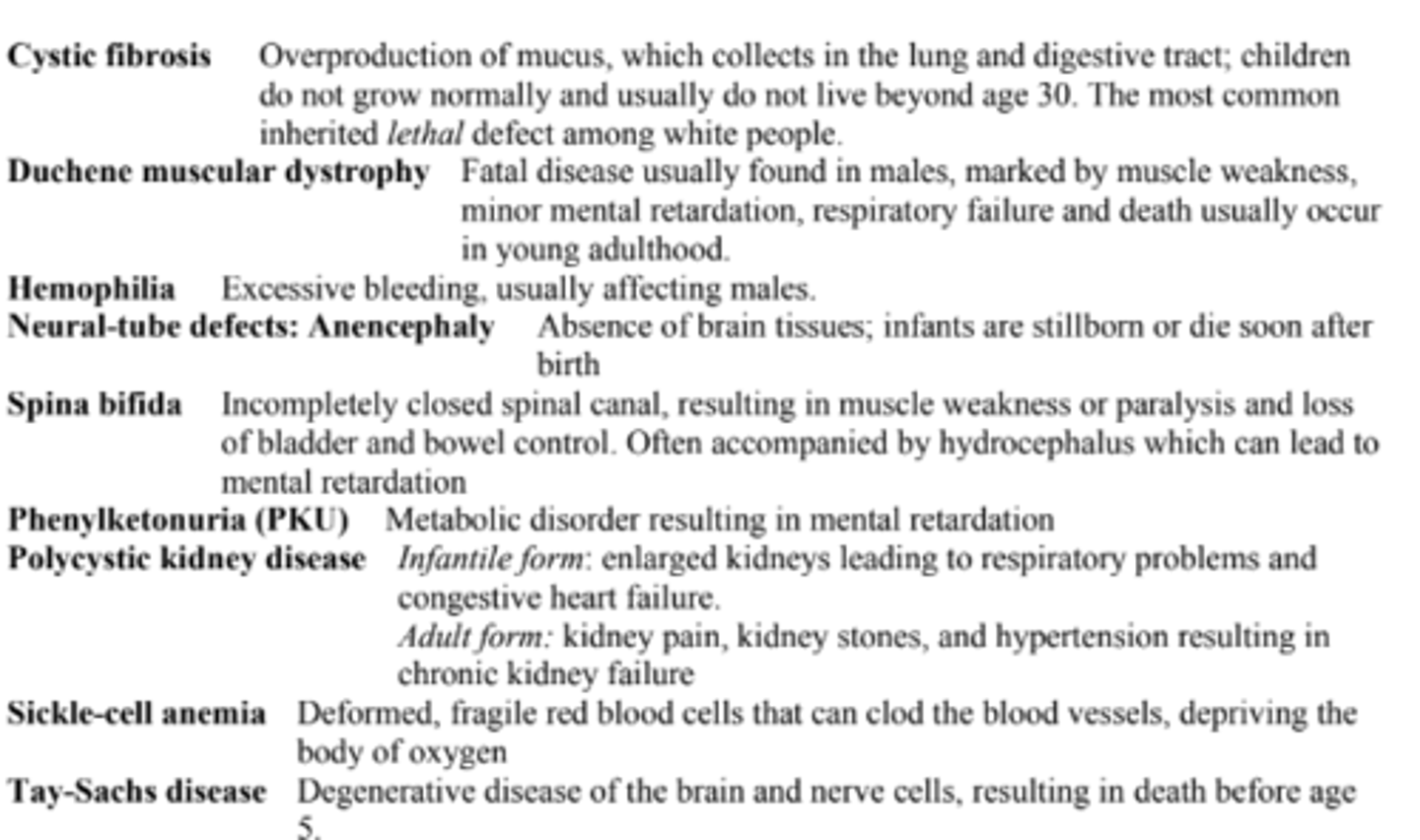
Gene-Linked Abnormalities
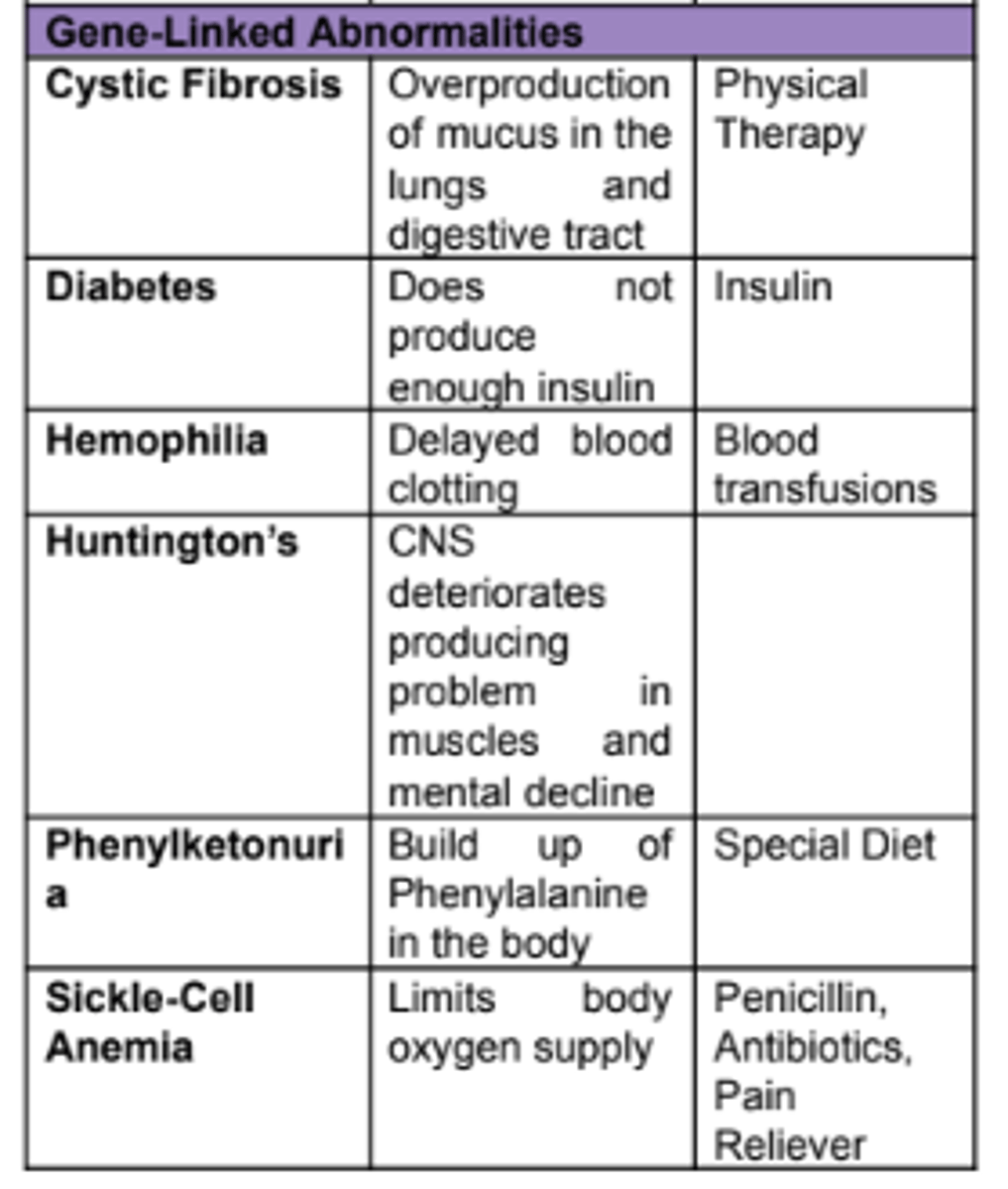
Gene-Linked Abnormalities
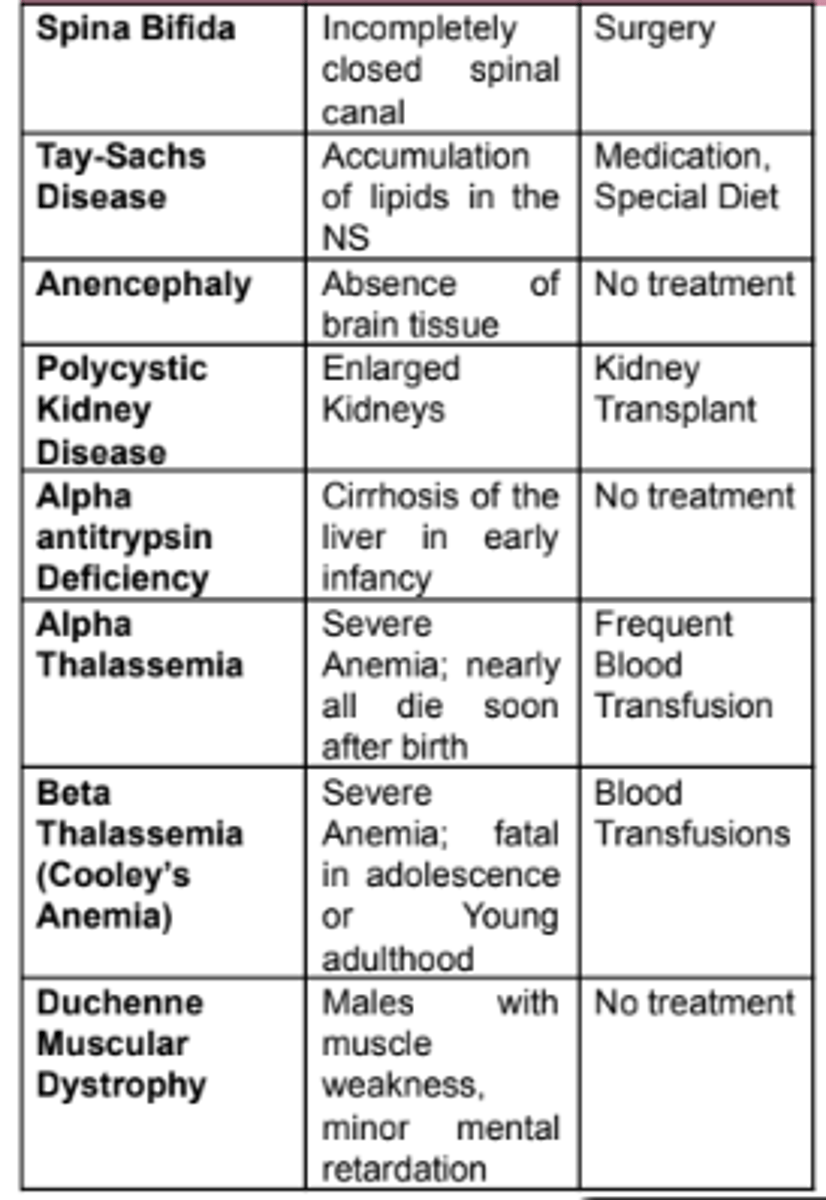
Birth Defects and Genetic Disorder
-Alpha1 antitrypsin deficiency
-Alpha thalassemia
-Cooley's anemia
-Cystic fibrosis
-Duchene muscular dystrophy
-Hemophilia
Alpha1 antitrypsin deficiency
Enzyme deficiency that can lead to cirrhosis of the liver in early infancy and emphysema and degenerative lung disease in middle age.
Alpha thalassemia
Severe anemia that reduces ability of the blood to carry oxygen; nearly all affected infants are stillborn or die soon after birth
Cooley's anemia
Severe anemia resulting in weakness, fatigue, and frequent illness; usually fata in adolescence or young adulthood.
Cystic fibrosis
Overproduction of mucus, which collects in the lung and digestive tract; children do not grow normally and usually do not live beyond age 30. The most common inherited lethal defect among white people.
Duchene muscular dystrophy
Fatal disease usually found in males, marked by muscle weakness, minor mental retardation, respiratory failure and death usually occur in young adulthood.
Hemophilia
Excessive bleeding, usually affecting males.
Neural-tube defects:
Absence of brain tissues; infants are stillborn or die soon after birth
-Anencephaly
-Spina bifida
-Phenylketonuria
-Polycystic kidney disease
-Sickle-cell anemia
-Tay-Sachs disease
Spina bifida
Incompletely closed spinal canal, resulting in muscle weakness or paralysis and loss of bladder and bowel control. Often accompanied by hydrocephalus which can lead to mental retardation
Phenylketonuria
Metabolic disorder resulting in mental retardation
Polycystic kidney disease
Infantile form: enlarged kidneys leading to respiratory problems and congestive heart failure.
Adult form: kidney pain, kidney stones, and hypertension resulting in chronic kidney failure
Sickle-cell anemia
Tay-Sachs disease
Degenerative disease of the brain and nerve cells, resulting in death before age 5.
cell division
Chromosomal abnormalities typically occur because of errors in ____; resulting in an extra or missing chromosome.
3. Chromosomal Abnormalities
Typically occur because of errors in cell division, resulting in an extra or missing chromosome.
o Klinefelter Syndrome (XXY): Caused by an extra female sex chromosome.
o Turner Syndrome (XO): Results from a missing sex chromosome.
o Down Syndrome/Trisomy-21: Characterized by moderate-to-severe mental retardation and by such physical
signs as a downward sloping skin fold at the inner corners of the eyes.
▪ The most common chromosomal abnormality.
▪ Extra 21st chromosome.
Chromosomal Abnormalities
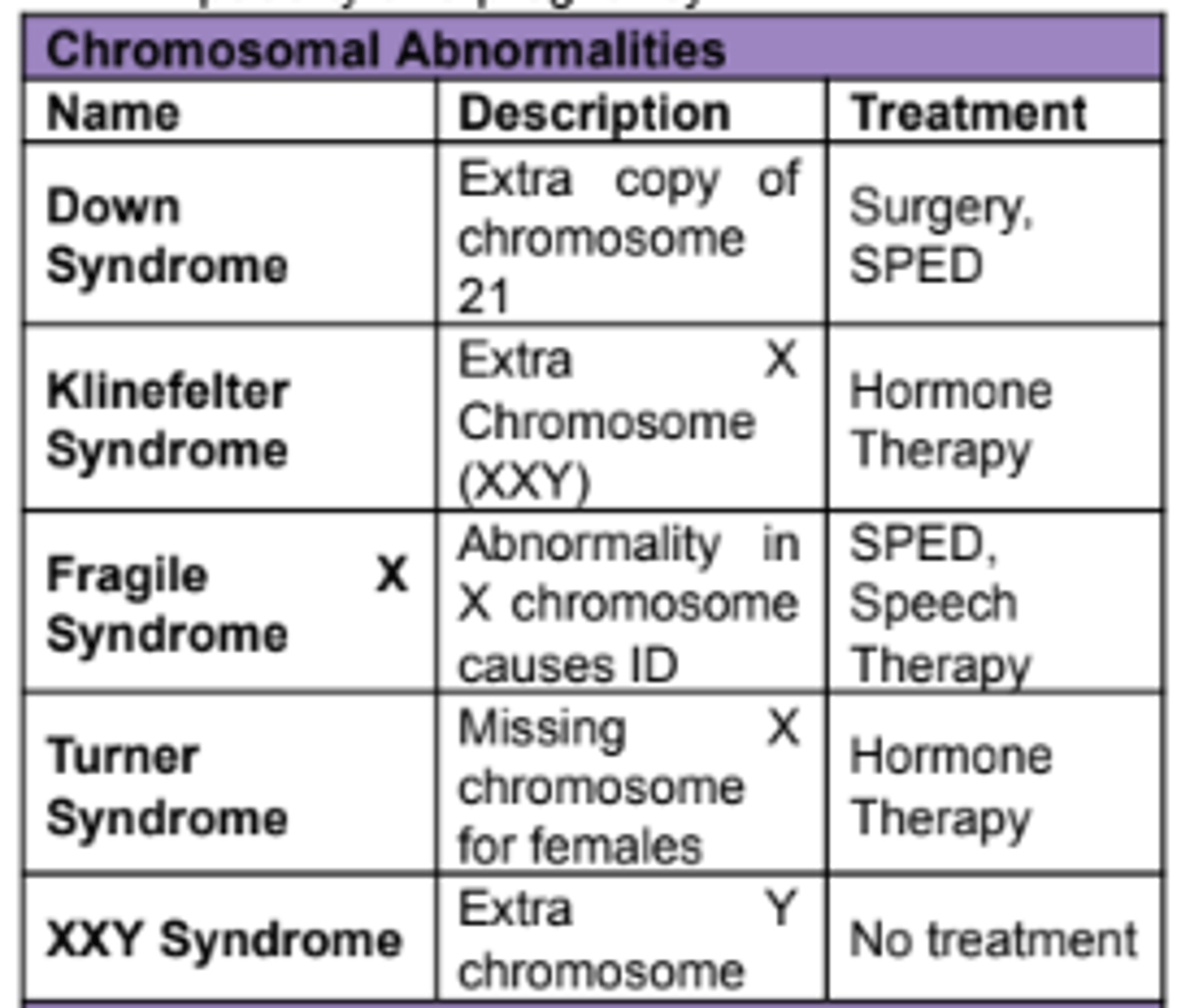
Chromosomal Abnormalities
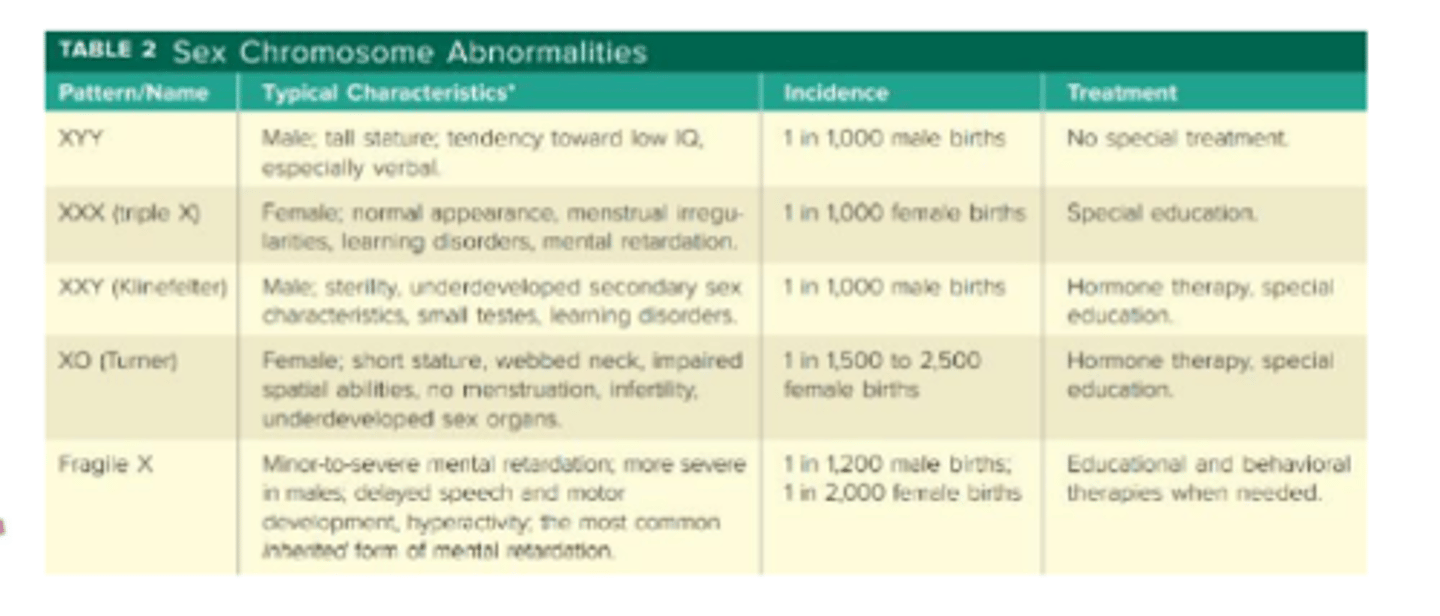
- XYY
- XXX (triple X)
- XXY (Kleinfelter)
- XO (Turner)
- Fragile
- Down syndrome aka trisomy-21
Sex Chromosomal abnormalities
XYY
Male; tall stature; tendency to low IQ, especially verbal.
XXX (triple X)
Female; normal appearance, menstrual irregularities, learning disorders, mental retardation.
XXY (Kleinfelter)
Male; sterility, underdeveloped secondary sex characteristics, small testes, learning disorders
XO (Turner)
Female; short stature, webbed neck, impaired spatial abilities, no menstruation, infertility, underdeveloped sex organs, incomplete development of secondary sex characteristics.
Fragile X
Minor-to-severe mental retardation; symptoms (which are more severe in males) include delayed speech and motor development, speech impairments, and hyperactivity.
This is also the most common inherited from of mental retardation.
Down syndrome aka trisomy-21
Because of an extra 21st chromosome, most obvious physical characteristic is the downward-sloping skin fold at the inner corner of the eyes. Hippocampal volume shrinks by young adulthood
5. GENETIC COUNSELING AND TESTING
Genetic Counseling: Help prospective parents assess their risk of bearing children with genetic or chromosomal defects.
• Takes a family history and gives the prospective parents and any biological children physical examinations.
• Laboratory investigations of blood, skin, urine, or fingerprints may be performed.
• Chromosomes from body tissues may be analyzed and photographed, and the photographs enlarged and arranged according to size and structure on a chart.
• Karyotype:
• Karyotype:
A chart showing an individual's complete set of
chromosomes.
o Can determine chromosomal abnormalities and can indicate
whether a person might transmit genetic defects to a child.
Nature and Nurture: Influences of Heredity and Environment
One approach to the study of heredity and environment is quantitative
1. STUDYING HEREDITY AND ENVIRONMENT
2. HOW HEREDITY AND ENVIRONMENT WORK TOGETHER
3. SOME CHARACTERISTICS INFLUENCED BY HEREDITY AND ENVIRONMENT
1. STUDYING HEREDITY AND ENVIRONMENT
Behavioral Genetics
Quantitative study of relative hereditary and environmental influences on behavior.
Heritability
a statistical estimate of the contribution heredity makes toward individual differences in complex traits within a given population.
Measuring Heritability
▪ Percentage ranging from 0.0 to 1.0: the higher the number, the greater the heritability of a trait.
▪ 1.0: 100 percent responsible for variances in the trait within the population.
▪ 0.0: Environment shaped a trait exclusively.
Heritability
➢ Family studies
➢ Adoption studies
➢ Twin Studies
o Concordant:
Term describing tendency of twins to share the same trait or disorder.
• *If heredity has a large influence on a particular trait, identical twins should be more alike on that trait than fraternal twins, and adopted children should be more like their biological parents than their adoptive parents!
➢ Family studies
researchers measure the degree to which biological relatives share certain traits and whether the closeness of the familiar relationship is associated with the degree of similarity. If the correlation is strong, the researched infer a genetic influence.
➢ Adoption studies
look at similarities between adopted children and their adoptive families and also between adopted children and their biological families.
o If the adopted children are more like their biological parents/siblings in a trait, the influence of heredity is present. But if it's more like their adoptive families, we see the influence of environment.
➢ Twin Studies
compare pairs of monozygotic twins with the same-sex dizygotic twins.
o If monozygotic twins have a statistically greater tendency to show the same trait (or are concordant) than dizygotic twins, there are likely effects of heredity.
2. HOW HEREDITY AND ENVIRONMENT WORK TOGETHER
-Reaction Range
-Canalization
-Genotype-Environment Interaction
-Genotype-Environment Correlation/Genotype- Environment Covariance
-Nonshared Environmental Effects
-Reaction range
Potential variability, depending on environmental conditions, in the expression of a hereditary trait.
refers to a range of potential expressions of a hereditary trait. Example is body size, though it depends on biological processes, and even if a range of sizes is possible, it is still dependent on environmental opportunities and constraints and a person's behavior.
-canalization
Certain behaviors also develop along genetically dug channels, and it takes an extreme change in environment to alter their course
-Limitation on variance of expression of certain inherited characteristics.
• Highly Canalized Traits: Motor development (crawling, walking, running), language.
• Not Highly Canalized Traits: Cognition and personality.
-genes and environment work together
- genotype-environment interaction
- genotype-environment correlation,
-genotype-environment interaction
the effects of similar environmental conditions on genetically different individuals.
The portion of phenotypic variation that results from the reactions of genetically different individuals to similar environmental conditions.
-genotype-environment correlation,
because genes influence a person's exposure to particular environments, the environment often supports genetic differences.
Tendency of certain genetic and environmental influences to reinforce each other; may be:
1. Passive correlations.
2. Reactive or evocative correlations.
3. Active correlations.
There are three ways to strengthen the phenotypic expression of a genotypic tendence. / environment enforces genetic influence.
1. Passive correlations.
2. Reactive or evocative correlations.
3. Active correlations.
Passive Correlation
Reactive Correlation
Active Correlations
picture

1. Passive correlations
Parents, who provide the genes that predispose a child toward a trait, also tend to provide an environment that encourages the development of that trait. It is called passive because the child has no control over it.
▪ Reflect a combination of genetic and environmental influences.
2. Reactive or evocative correlations.
Children with differing genetic makeups evoke different reactions form adults. The parents react to the child's genetic makeup.
▪ Children evoke, or pull out, certain responses from others.
▪ Eg. parents who are not musically inclined may make a special effort to provide musical experiences for a child who shows interest and ability in music.
3. Active correlations
As children get older and have more freedom to choose their own activities and environments, they actively select or create experiences consistent with their genetic tendencies.
▪ Eg. An adolescent with a talent for music will probably seek out musical friends, take music classes, and go to concerts.
3a. niche-picking.
The tendency to seek out environments compatible with one's genotype
- Nonshared Environmental Effects
result from the unique environment in which each
child in a family grows up.
The unique environment in which each child grows up, consisting of distinctive influences or influences that affect one child differently than another.
3. SOME CHARACTERISTICS INFLUENCED BY HEREDITY AND ENVIRONMENT
-Obesity
-Intelligence
-Temperament and Personality
-Schizophrenia
Prenatal Diagnostic Tests
1. Ultrasound Sonography
2. Fetal MRI
3. Chorionic Villus Sampling
4. Amniocentesis
5. Maternal Blood Screening
-Obesity
Extreme overweight in relation to age, sex, height, and body type as defined by having a body mass index at or above the 95th percentile.
• The risk of obesity is 2 to 3 times higher for a child with a family history of obesity.
• Environmental Experiences: The kind and amount of food eaten in a particular home and the amount of exercise that is encouraged.
-Intelligence
-Temperament and Personality
Temperament: Characteristic disposition, or style of approaching and reacting to situations.
-Schizophrenia
Mental disorder marked by loss of contact with reality; symptoms include hallucinations and delusions.
• Estimates of heritability range from 60 to 80 percent.
PRENATAL DEVELOPMENT
development from conception to birth
1 STAGES OF PRENATAL DEVELOPMENT
2 ENVIRONMENTAL INFLUENCES: MATERNAL FACTORS
-Gestation
-Gestational Age
-Pregnancy Test
-Gestation
Period of development between conception and birth.
• Normal range of gestation is between 37 and 41 weeks